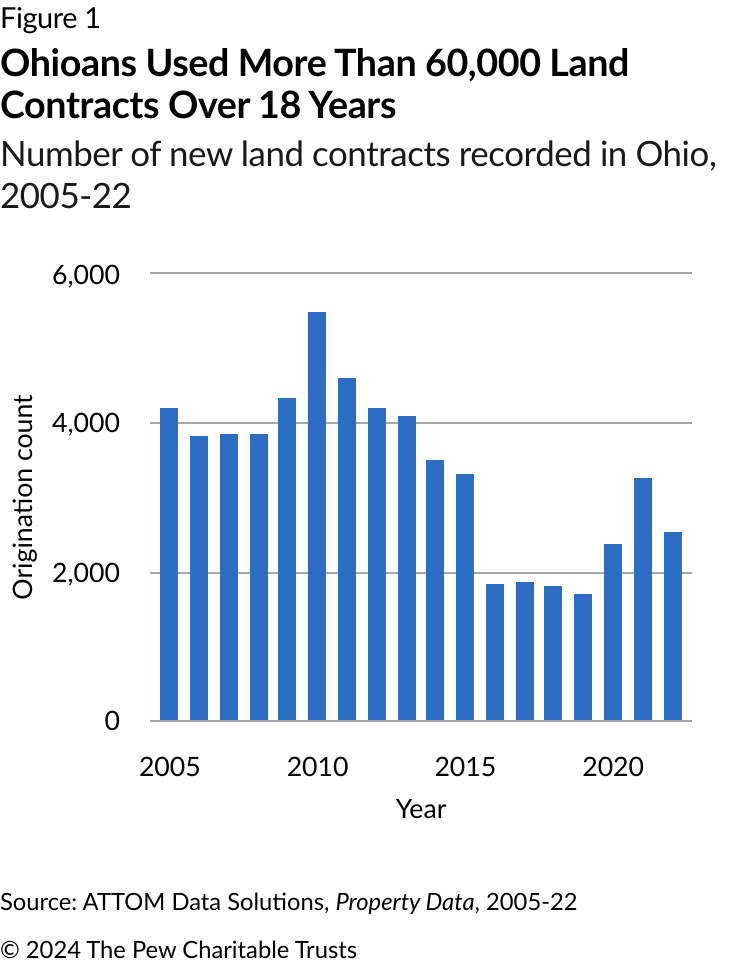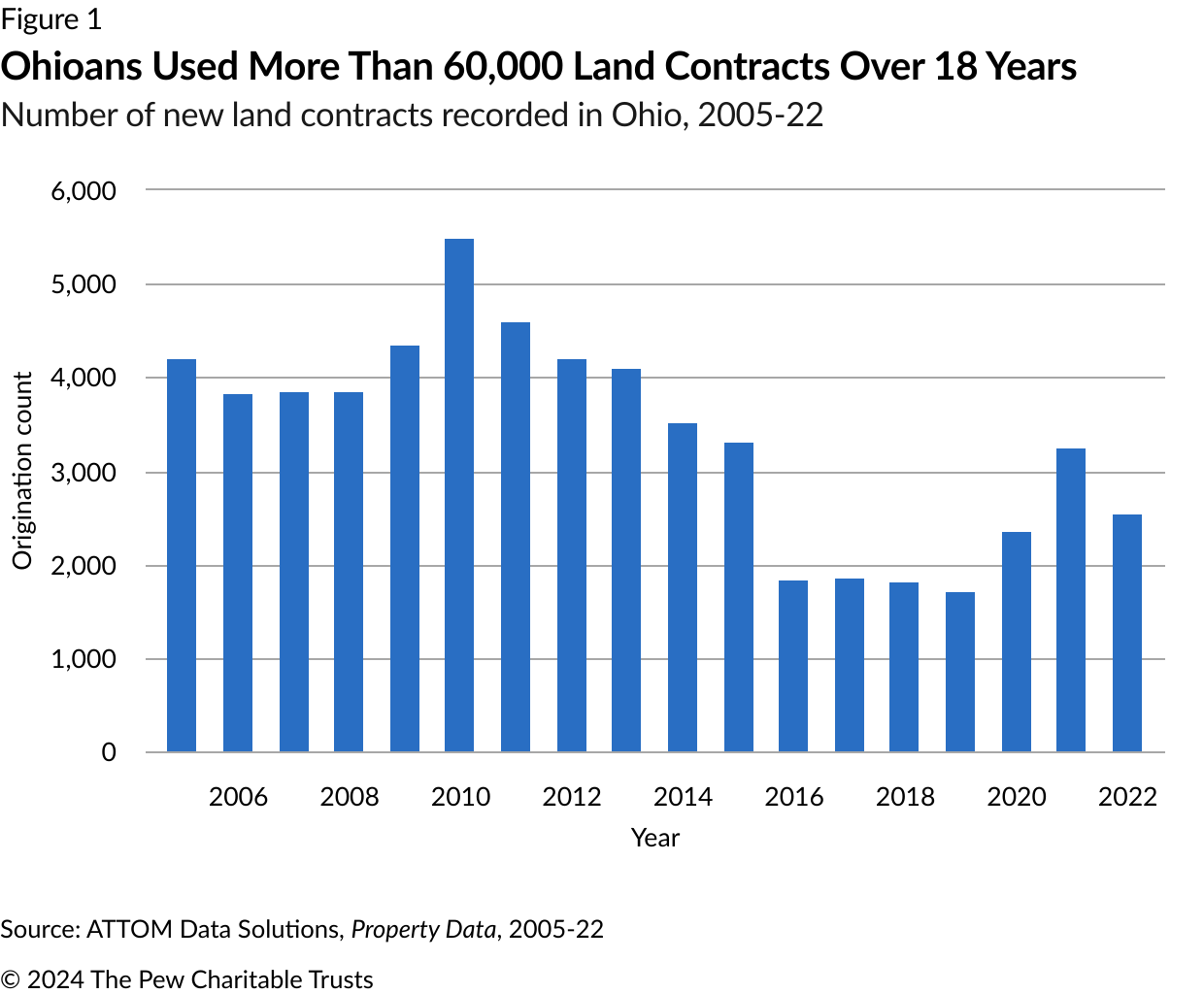Thousands of Ohio Homebuyers Have Used Land Contracts Over the Past 2 Decades
A review of the state’s market and consumer protections

Overview
From 2005 to 2022, homebuyers in Ohio entered into more land contracts than in almost any other state. Land contracts, also known as “contracts for deed” or “land installment contracts,” are an alternative form of home financing that does not involve banks or mortgage lenders. Instead, they involve the seller extending credit directly to the homebuyer, who then agrees to make regular payments over an agreed duration. Because a land contract is a direct negotiation between buyer and seller, terms can be more flexible than those for mortgages, which can help buyers who would not qualify for a mortgage, access credit.1 Survey data shows that many land contract buyers report ultimately attaining homeownership.2
However, some Ohioans have reported negative experiences with land contracts, including dilapidated properties, unpaid property taxes, and high interest rates.3 These issues reflect the differences in land contract and mortgage transactions and the consumer protections that apply to each. Unlike mortgages, land contracts do not transfer full ownership of the property to the buyer at the time the agreement is initiated; the seller retains the title to the property until the final payment is made. This puts the buyer’s financial investment at risk and creates ambiguity about which party is responsible for financial obligations, such as property taxes, homeowners’ insurance, and home upkeep.
This fact sheet looks at the prevalence and distribution of—as well as the state and local consumer protection statutes for—land contract purchases in Ohio.
Ohio’s land contract market
Land contracts are common in Ohio. From 2005 to 2022, county governments recorded 60,537 land contracts in the state—the second-most among all states. The number of land contract recordings peaked in Ohio in 2010 and has generally tended to rise and fall in line with national trends. (See Figure 1.)

Land contracts are most common in urban areas. Franklin County, which contains Columbus, recorded 3,076 land contracts, the most in the state. Land contracts were also prevalent in Montgomery County, home to Dayton (2,967); Trumbull County, where Warren is located (2,922); and Stark County, which contains Canton (2,889). (See Figure 2.)
Land contracts are mostly used to purchase residential properties. More than 80% of Ohio land contracts were used to purchase homes, and the rest were mostly used for agricultural or commercial properties.
Land contracts in Ohio are used to purchase low-cost properties. The median value of a land contract in Ohio was about $71,000, which is less than half of the state’s 2022 median home price of $174,000.4
Most land contracts in Ohio are executed between individuals. More than 70% of the land contracts in Ohio involved one person selling a home to another person. About 18% involved a corporate entity selling to an individual buyer, with the balance being corporate entities selling to corporate buyers.
State and local land contract statutes in Ohio
Ohio sellers are required to record contracts. Sellers must submit contracts to their county recorder’s office within 20 days of execution and disclose to the buyer any fees charged that are separate from the contract price.
Buyers are entitled to receive annual disclosures. Sellers must provide, upon request from the buyer, details of how the buyer’s monthly payments have reduced the outstanding principal balance.
Ohio affords land contract buyers only a 30-day window to catch up on missed payments. This is less than mortgage borrowers are entitled to through the state’s foreclosure process.
The city of Toledo requires sellers to prove that their properties have passed a building code inspection.5 To protect homebuyers from being saddled with unsafe or uninhabitable homes, the city in 2008 passed an ordinance mandating that sellers provide appropriate documentation before executing a land contract.
Cincinnati requires that sellers obtain a certificate of occupancy. In 2018, the city passed legislation that obliged sellers to formalize the buyer’s right to live on the property before entering into a land contract and that allowed buyers to bring legal action against sellers who fail to meet their legal obligations.6
Endnotes
- “Land Contracts: Predatory or a Pathway to Upward Mobility?,” Evelyn Zwiebach, Enterprise Community Partners, Aug. 26, 2022, https://www.enterprisecommunity.org/blog/land-contracts-predatory-or-pathway-upward-mobility.
- The Pew Charitable Trusts, “Home Financing Incidence Survey,” 2021, https://www.pewtrusts.org/-/media/assets/2022/04/incidence-survey_topline.pdf.
- Matthew Goldstein and Alexandra Stevenson, “Market for Fixer-Uppers Traps Low-Income Buyers,” The New York Times, Feb. 20, 2016, https://www.nytimes.com/2016/02/21/business/dealbook/market-for-fixer-uppers-traps-low-income-buyers.html.
- Ohio Housing Finance Agency, “Ohio Housing Needs Assessment Executive Summary: Fiscal Year 2024-2025,” 2023, https://ohiohome.org/news/documents/24-25-HNA-ExecutiveSummary.pdf.
- Toledo Municipal Code, City of Toledo, 2015, https://codelibrary.amlegal.com/codes/toledo/latest/toledo_oh/0-0-0-153591.
- Municipal Code of Cincinnati, City of Cincinnati, 2018, https://library.municode.com/oh/cincinnati/codes/code_of_ordinances?nodeId=TITVIIIBURE_CH870LAINCO.












